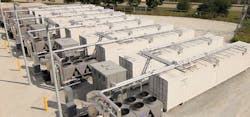Is Utility-Scale Advanced Battery Storage Now Mainstream?
According to the trade press, utilities across the country are making commitments to advanced battery storage projects. In many cases, the companies cited are the usual suspects, announcing storage projects and purchase arrangements or including placeholders in integrated resource plans because of state regulatory or policy directives. So, can we finally conclude that utility-scale advanced battery storage has gone mainstream?
Let’s take a look at one of the promising arguments for “mainstream achieved.” California. After years of explosive solar development, in addition to pushing for storage commitments from the state’s major utilities, California recently reopened its Self Generation Incentive Program (SGIP) with a huge emphasis on energy storage projects. Under the new round, 79% of SGIP’s $567 million budget through 2019 is earmarked for energy storage projects. This falls on the heels of a major push to install longer duration batteries for peak demand capacity when the Aliso Canyon natural gas storage facility was shut down in 2015. That initiative resulted in California being the number-one installer of new utility-scale battery storage capacity in 2016.
When one looks beyond California for pro mainstream arguments, we see a number of states are discussing advanced energy storage commitments and a few are taking action. Arizona and Hawaii, like one might expect, are looking to storage to handle huge amounts of solar development and in Hawaii’s case also to help achieve its goal of 100% renewables by 2045. A more surprising example is New York. As part of the state’s REV program to revamp its electric power industry, NYSERDA recently announced $15.5 million in funding for energy storage projects. Also, as elsewhere, we are seeing advanced storage activity news in NY that usually concerns utilities installing demonstration projects. For example, ConEd currently has a 1-MW energy storage demonstration project under development and National Grid Generation has filed an application with the NYSPSC to lease land on Long Island for a 5-MW, 40-MWh battery storage facility.
While California was ranked number one for advanced storage deployments in 2016, the multistate PJM region historically has held the honor for the largest concentration of installed utility-scale advanced energy storage projects with more than 266 MW. The driver in PJM was favorable regulation market incentives. However, as more advanced energy storage projects come online in PJM and other wholesale markets, developers are increasingly at odds with existing market rules designed for different resources or older technologies. In PJM, changes made by the system operator to its frequency regulation rules have led to a FERC complaint by the Energy Storage Association, alleging discrimination against very short response time resources like advanced battery storage technologies. In MISO the complaint is that lithium-ion batteries wanting to participate in the market would be forced to operate in a way that would degrade their batteries.
So it appears there are growing pains with advanced storage and, yes, much of the activity in the news is about demonstration or “planned” projects. So, filtering through the hyperbole, can we conclude that advanced storage has finally gone mainstream or aren’t we there yet? According to “GTM Research/ESA U.S. Energy Storage Monitor” 221 MW of energy storage was installed in 2016 with a total power capability of roughly 340 MWh. While encouraging for the industry and impressive for demonstration purposes, it is hard to argue based on such figures that storage is now mainstream.
Developers of advanced storage systems will argue that they are making it ever easier to capture multiple value streams. UniEnergy Technologies, for example, produces a modular Vanadium Flow Battery system that it claims can simultaneously participate in multiple revenue markets, such as capacity, energy and ancillary services. This is referred to as “value stacking,” a strategy employed by storage vendors and developers when a single use doesn’t cover the cost of an installation. Stacking may be the path forward, at least for a while longer, as we wait for the cost of advanced battery storage to continue its downward trend and for market rules to become a bit more accommodating. Check out the following study for an encouraging and robust analysis of the trends in the levelized cost of storage (LCOS): https://www.lazard.com/media/438042/lazard-levelized-cost-of-storage-v20.pdf. Utility-scale advanced battery storage may not yet be mainstream, but it is getting closer by the day.
About the Author
David Shadle
Grid Optimization Editor
Dave joined the T&D World team as the editor of the Grid Optimization Center of Excellence website in January 2016.
Dave is a power industry veteran with a history of leading environmental and development organizations, championing crucial projects, managing major acquisitions and implementing change. Dave is currently a principal at Power Advance, LLC, an independent consulting firm specializing in power project development, research and analysis, due diligence and valuation support. Dave is also a contributing consultant for Transmission & Distribution World. Prior to Power Advance, Dave held business and power project development positions with The Louis Berger Group, Iberdrola Renewables, FPL Energy and General Public Utilities. He is a graduate of Pennsylvania State University, the New Jersey Institute of Technology and Purdue University.
